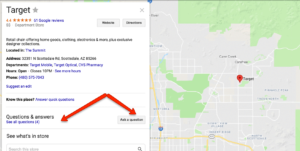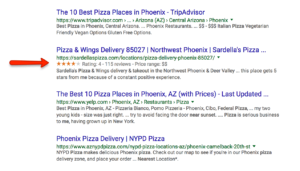When content and search engine optimization (SEO) converge, they can give you a big advantage…

October 19, 2019 | Mindy Weinstein | SEO |
Local Business SEO Checklist
Whether you run a large chain or a local business, good SEO practices are a must. However, local businesses usually don’t have the funds and resources that larger corporations have access to. This doesn’t mean that as a local entrepreneur, you can’t successfully market your product or services and increase sales.
The following SEO checklist for local businesses will point you in the right direction to get started on prioritizing SEO tasks, including what you need to do, why it makes a difference in improving SEO, and the time commitment required.
Analyze the Competition
If your business is already at the top of the list, fantastic. If not, the best way to determine where you’re lagging is to check out competitors’ sites. Pick the top five to 10 competitor sites and go through them. Do they load faster than your site? Are there targeted keywords you don’t use?
When doing a competitive analysis, use tools to find out what those sites are ranking for; how many pages they have indexed; their website structures; and the quality of their backlink profiles.
Tools: SEMrush, SpyFu, Majestic, BuiltWith.com
Time commitment: Medium
Anticipate Customer Needs
Before hiring a developer to create canonical tags and other SEO information, you need to figure out what your potential customers might be looking for in your site when using a search engine. For example, why and when do they want your product? Is it a spur-of-the-moment search? Is it a search for themselves or someone else? For purchasing or just information? What device might clients use?
Knowing all this will help you use the correct language, keywords, and content when creating your site.
Tools: Whiteboard
Time commitment: Medium
Manage Local Business Listing and Citations
Data aggregators (e.g., Neustar Localeze, Factual) share information about local businesses, including name, address, and phone number (NAP). Make sure your business’ NAP information is consistent and accurate. Local business listings and citations (online mentions of a business) can help improve your local presence.
The best approach to local directories and citations is to sign up for a service that will distribute your NAP information.
Tools: Yext, BrightLocal, WhiteSpark
Time commitment: Low
Fix Technical SEO Issues
If it’s broken, fix it. You might have the most incredible-looking website, but if a customer needs to be redirected to another page and is redirected to the wrong page, you’ve lost a potential sale. Duplicate content may confuse users and crawlers can filter out your site because of duplication.
Make sure the loading speed is as fast as you can get it. Web users expect prompt service on demand. Canonical link elements should be as accurate and effective as possible. Fix any broken links.
Tools: SEMRush, Google Search Console, GT Metrix, Siteliner and Screaming Frog
Time commitment: High
Optimize Your Pages
On-page optimization is more than just putting keywords on the page.
You must develop quality content that is properly structured, using natural characteristics for the targeted keywords. This means determining which keywords make an impact, using images to enhance content and make your point, and increasing the loading speed as much as possible. Optimize your titles and meta descriptions as well.
For local businesses, it is important to use keywords that will draw in the locals. For example, if your business is near the Adirondacks, you might consider using “upstate New York” as keywords. In Washington State, you would use “Tri-Cities” instead of Kennewick, Richland, and Pasco. Those living nearby will search for services using local terminology.
Your site should be high quality, mobile-friendly, secure, and easy to navigate. All this will help your site move up in rankings.
Tools: SEMRush, Google Search Console, SpyFu, Keywords Everywhere
Time commitment: High
Optimize Google My Business
Google My Business should be a focal point for any local business. It’s free, easy to update, and can make a big impact.
The first step toward optimizing your Google My Business listing is claiming and verifying it: https://www.google.com/business. Fill out as many fields as you can, and include photos and videos to enhance your listing. Choose the correct categories for your business.
In local search results, there is a section where people can ask questions and get answers. As a local business, you must stay on top of these questions. Here’s how these questions appear in local results:

Mike Blumenthal wrote a great guide about these Q&As, which is worth the read: The Big Guide to Google Questions And Answers (Q & A).
Tools to use: Google My Business
Time commitment: Low
Add Schema Markup
Search engines receive signals about your business via schema markup. The markups include your NAP, service hours, and ratings. For SEO, use JSON-LD (JavaScript Object Notation) markup. You can see markups in action within the SERP below.

Check out schema for local businesses here: https://schema.org/LocalBusiness.
Tools: Google Structured Data Testing Tool
Time commitment: Medium
Get Reviews
There are so many products and services available in today’s world, that it’s impossible to expect someone you know and trust has purchased whatever you are thinking about buying. This is when reviews come in handy.
Reviews play a major part in many potential customers’ decisions to buy from businesses. Encourage users to leave reviews and include any links to reviews of your product on reputable sites.
Tools: Yext, Get Five Stars
Time commitment: High
Create Videos & Images for Competitive Keywords
“A picture paints a thousand words.” Enhance content with high-quality graphics and videos. If you are having difficulty coming up with keywords for your site, optimize a video or image.
Tools: Keyword Tool, SpyFu, SEMRush
Time commitment: Medium
Get Links From Websites in Your Area
Links are the online versions of referrals and word of mouth. Contact local bloggers within your field or charities willing to trade a donation for a sponsored link. The more people click on your link, the higher your ranking goes — which means search engines rank your site higher on the list.
For ideas on how to get local links, check out the article, What Is a Local Backlink & How to Find Them.
Tools: Ahrefs, SpyFu, Majestic
Time commitment: High
Mix Paid With Organic
It can take a while to see SEO results, but it’s important to invest the time and money necessary to improve your SEO. However, if you want leads right away, a paid search is beneficial. While you are building up your SEO work, set aside a budget for paid so you can keep the leads coming in.
Even after you have a steady flow of organic traffic to the website, consider running a paid search campaign in conjunction.
Tools: Google Auction Insights, Bing Ads Keyword Planner Tool
Time commitment: High
Summary
This list may seem a bit overwhelming, especially if you are a new business owner or haven’t delved into the technical side of marketing. Don’t worry; you don’t have to follow all these recommendations at once. Just pick one or two and start working on them. Once they are done, you can move on when you have the time and finances.
Have a Shopify site? Read this article for specific recommendations: Shopify SEO: Tips to Help Improve Your Online Presence.